In types of suit, few terms cause more confusion than the phrase lounge suit. You’ve seen it on wedding invitations, corporate event dress codes or even style guides, but what does it really mean? Is it a type of casualwear, or something more refined? In this article, we’ll unravel exactly what a lounge suit is, how it fits into modern dress codes and the reason make it remain a timeless staple in the world of classic menswear.
1. What is a lounge suit
A lounge suit is a traditional term used to describe a matching two-piece or three-piece suit, typically includes a jacket and trousers made from the same fabric, throw in a a waistcoat too, if you feel like it. It is the standard form of men’s smartwear for formal, business settings or semi-formal events.
While the phrase lounge suit may sound casual to the modern ear, this type of suit is far from loungewear. In fact, it’s considered appropriate attire for special occasions such as weddings, interviews, formal luncheons and professional meetings.
Some would say that the lounge suit is just an old name of the suit that we have today. But that’s oversimplified. For example, tuxedos or morning dress are distinct categories. Lounge suits specifically refer to the less formal, daywear suits that became the standard for business and semi-formal occasions.

2. A brief history of the lounge suit
The lounge suit’s origin date way back to the mid-19th century in Britain, where it first emerged as a form of relaxed countrywear for the richs and noblemans. Unlike the more rigid and ceremonial garments of the era, the lounge suit offered a softer and more comfortable silhouette, designed for lazing around at country estates rather than for formal urban occasions.
As the society evolved, so did the suit. By the Edwardian era, the lounge suit had started to gain traction in city life, gradually replacing the morning suit as the more preferable choice for business and everyday professional wear. Tailoring became sharper, silhouettes more refined, and the suit transitioned from something casual to a symbol of respectability, competence and modern masculinity.
Through the 20th century, the lounge suit adapted to the times with features like broad shoulders and wide suit lapels in the 1930s, slimmer cuts in the 1960s and the return of classic proportions in recent decades. Despite changing trends, until today its core identity has remained the same: a versatile, matching 2 or 3-piece ensemble that balances comfort and class.

3. Key features of a lounge suit
Though styles may vary slightly depending on fashion trends or personal taste, the lounge suit maintains several classic characteristics that distinguish it as a refined and versatile menswear staple.
The jacket
At the heart of the lounge suit is the tailored jacket which commonly comes in a single-breasted design, featuring two or three buttons, offering a clean and contemporary silhouette that flatters a wide range of body types. If you wanna have a bolder or more traditional, a double-breasted suit jacket can help you adds structure and a sense of vintage elegance to your look.
Lapel styles also play a role in defining the jacket’s character. Notch lapels are the most standard and versatile, while peak lapels add formality and visual strength. Occasionally, shawl lapels appear in more fashion-forward or semi-formal versions of the lounge suit, especially in evening party or gala.

The trousers
Matching trousers that are crafted from the same fabric as the jacket is a must to create a cohesive and polished appearance. Lounge suit trousers typically feature a classic straight or slightly tapered cut, designed to drape cleanly over the leg without being overly slim or baggy.
Depending on the formality of the occasion and personal style, you may choose cuffed hems for a traditional flair or go uncuffed for a more modern, streamlined finish.
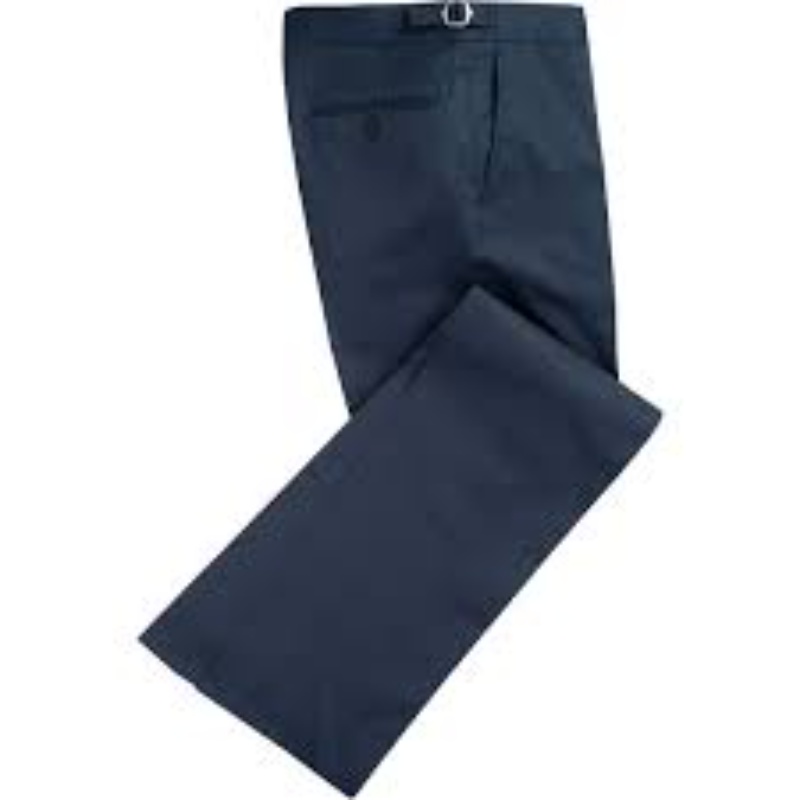
The waistcoat
In a three-piece lounge suit, a waistcoat adds an extra layer of formality and sophistication. It’s particularly suitable for weddings, formal daytime events or any occasion where you want to make a sharp, distinguished impression.
A well-fitted waistcoat should lie flat, sit just below the belt line, and complement the rest of the suit without excess bulk.
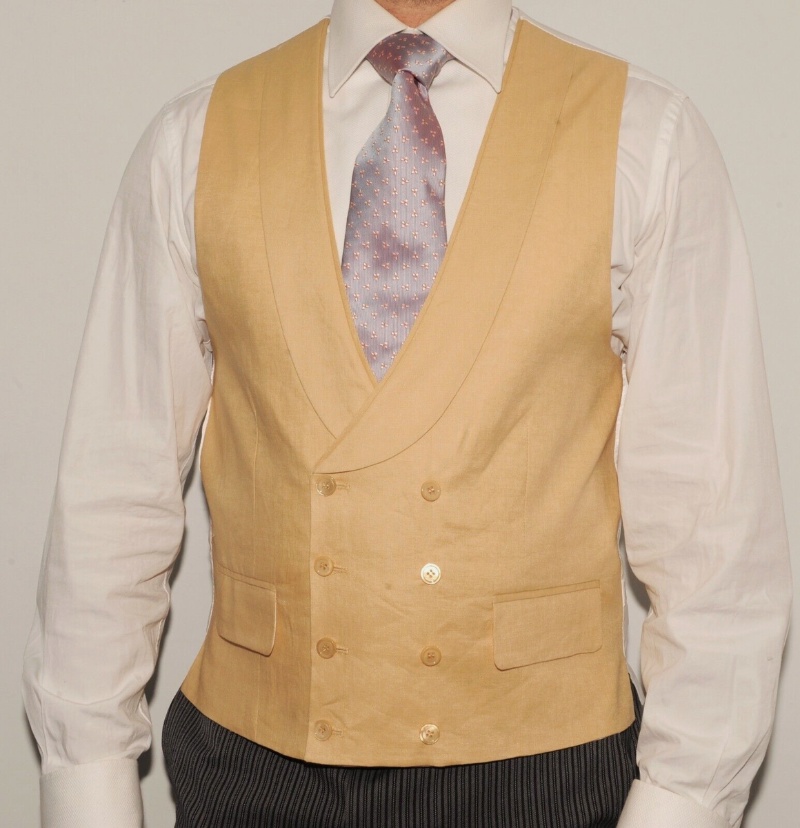
Common fabrics
Material plays a significant role in both the look and feel of a lounge suit. Wool remains the gold standard, prized for its drape, breathability and seasonless versatility.
For warmer climates or summer wear, cotton and linen suits offer a lighter, more relaxed vibe, though they tend to wrinkle more easily. Tweed, with its textured finish and heavier weight, is ideal for autumn and winter, bringing both warmth and heritage character to your outer look.
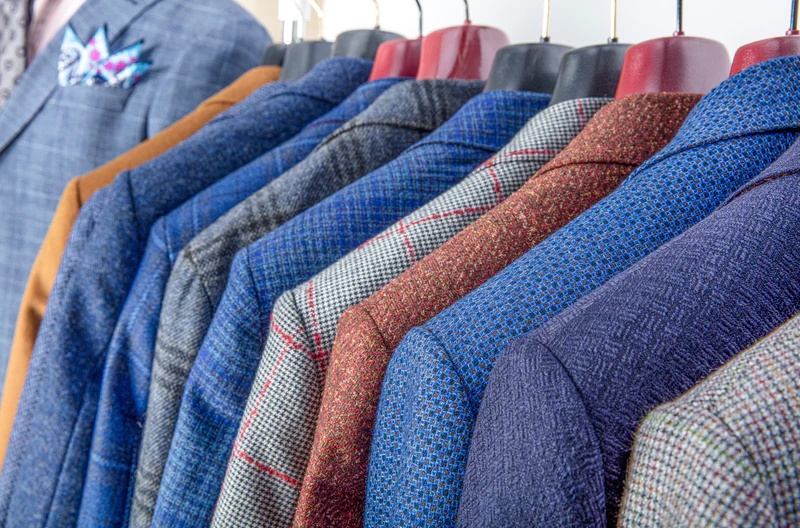
Classic colors
When it comes to color, a timeless lounge suit sticks to a neutral, understated palette. Navy blue, charcoal grey and mid-grey are the most versatile and widely accepted options, suitable for both business and social settings.
Beige and lighter tones may be worn in spring or summer for a softer, more casual interpretation. These classic shades not only pair easily with shirts and accessories, but they also reflect the essence of the lounge suit: balanced, refined and endlessly wearable.

4. When is a lounge suit appropriate?
A lounge suit is one of the most versatile dress codes a men can get his hand on, which strikes the perfect balance between formal elegance and modern practicality. While not as serious as a black tie, it still communicates respect for the occasion and attention to personal style.
So when is it the right choice?
Weddings are perhaps the most common setting where you would want to wear a lounge suit, particularly daytime or semi-formal weddings. These place make a full tuxedo feel too grand, but business attire would be too casual. That’s the perfect time for a lounge suit’s appearance.
A navy or mid-grey lounge suit paired with a crisp white shirt and soft-toned tie creates a look that’s elegant yet relaxed, ideal for celebrating such a meaningful occasion.
In the professional world, the lounge suit remains the gold standard for business meetings, conferences, and corporate events. It presents you as polished, prepared and respectful. These are the qualities that matter whether you’re closing a deal or making a first impression.
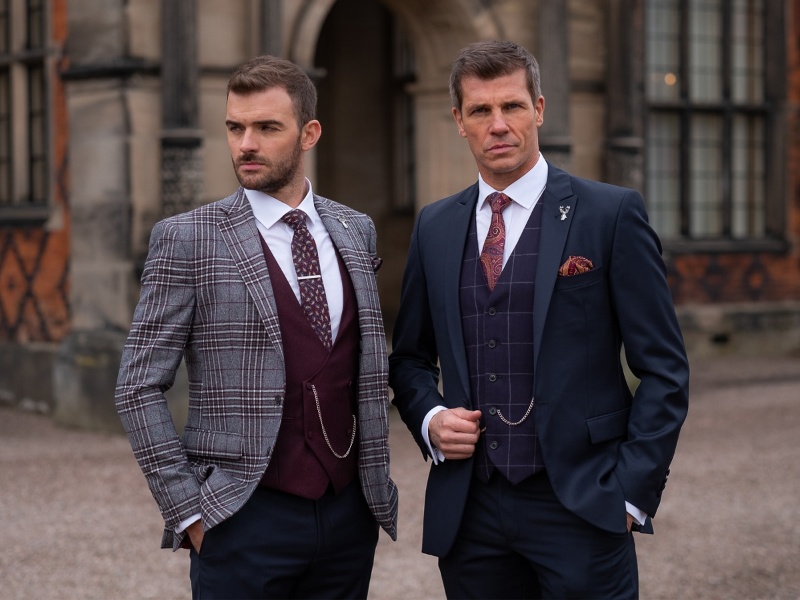
For more somber occasions like when you need a funeral suit, a dark lounge suit like charcoal or black paired with a white shirt and muted tie provides an understated and respectful appearance, in line with tradition and tone.
Finally, a lounge suit is perfectly suitable for cocktail parties or semi-formal events, especially when paired with slightly more expressive accessories like a patterned pocket square or textured tie. It gives you room to show personality while maintaining an air of smart sophistication.
5. Lounge suit vs Business suit: Is there any differences?
If you had read anything above, you may wonder if this two terms are interchangeable: lounge suit and business suit. While they share several similarities, there are subtle distinctions that set them apart, particularly when it comes to context, fabric and style details.
The lounge suit
A lounge suit is generally more versatile, designed to be appropriate for a wide range of social and formal occasions. While it can certainly be worn in business settings, it is also suitable for events like weddings, cocktail parties or daytime social gatherings.
These suits often feature softer tailoring, which gives them a slightly more relaxed appearance compared to the business suit. The cut of the jacket tends to be less structured, and the overall look leans toward elegance with a touch of comfort.
Lounge suits are typically crafted in neutral colors like navy, charcoal and grey are often paired with shirts and ties that are not overly bold or formal.
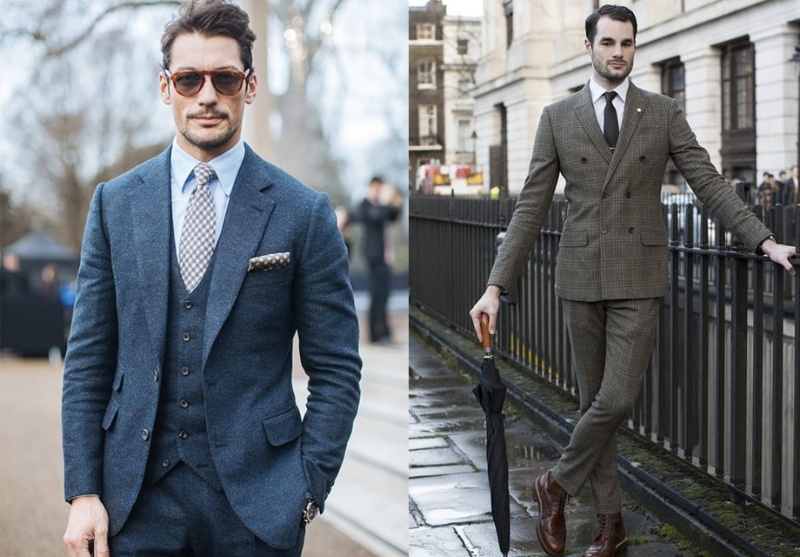
The business suit
On the other hand, the business suit is traditionally reserved for professional environments. It’s a more formal choice for the office, corporate events or job interviews b’cause it can projects authority, professionalism and respect.
Business suits tend to be sharper in their tailoring, with more structured shoulders, sharper lapels with a cleaner, more polished silhouette. The colors are generally conservative like dark navy, charcoal or black. Though keep in mind that in certain industries, lighter colors and subtle patterns like pinstripes may be appropriate.
The key difference lies in the overall formality. A lounge suit offers a broader range of styling options, from formal to semi-formal, while the business suit is almost exclusively a professional garment, meant to convey a serious, business-minded persona.
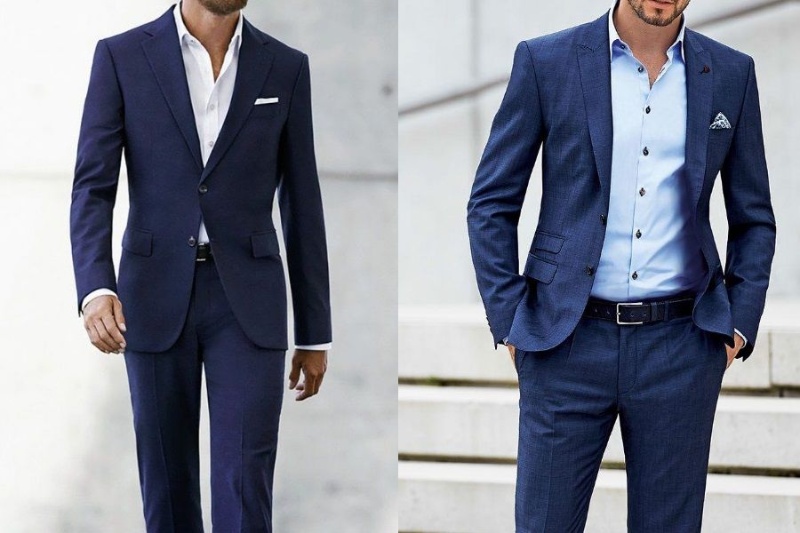
6. Styling tips: How to elevate your lounge suit look
A lounge suit is a versatile and timeless piece, but how you style it to elevate your look and make a lasting impression? These styling tips will help you get the most out of your lounge suit and ensure you’re dressed to impress, for sure.
The fit is everything
The most important element in making a lounge suit look sharp is its fit. A well-tailored suit that fits your body’s contours will instantly elevate your appearance.
Make sure the jacket shoulders align with your own, the sleeves show about half an inch of shirt cuff, and the trousers fall neatly over your shoes without excess bunching. If you can, opt for made-to-measure or bespoke suit, which will ensure the best fit for your unique body shape.

Stay classic with a crisp shirt
Underneath your lounge suit, a crisp white shirt is a foolproof choice to make everthing come with sophistication. However, don’t be afraid to explore subtle patterns or light blue tones for a bit of variety.
A shirt with a spread collar works well with a lounge suit, providing enough space for your tie without looking overly stiff. Just make sure that the shirt is well-pressed and free of wrinkles for a neat and clean look.

Shoes formality
The right pair of shoes is essential for completing your lounge suit ensemble. Stick to classic leather shoes such as oxfords, brogues or derbies. They would never let you down.
For a formal occasion, black leather shoes are often the best choice, while brown leather works for more relaxed or daytime events. Always ensure your shoes are polished, and choose dark-colored socks that complement your trousers.
Right tie makes all the difference
When selecting a tie for your lounge suit, simplicity and balance are key. A silk tie in a solid color or subtle pattern is always a safe bet. For a more modern look, experiment with different textures such as a knitted tie or one with a slight sheen.
Make sure the tie’s width complements the lapels of your jacket: narrow ties for slimmer lapels, wider ties for broader lapels. Remember, your tie should reach just the top of your belt buckle for the perfect length.
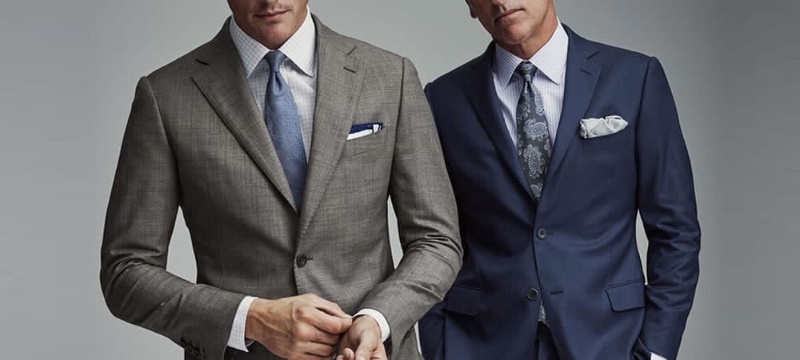
Pocket square speak personality
A pocket square is a small but effective way to add a personal touch to your lounge suit. Opt for a simple, elegant fold for a more refined look or a more creative, triangular fold for a bolder statement. Stick to complementary colors that work with your tie and suit, but feel free to add a pop of color or a pattern to infuse some personality into your outfit.
Don’t forget the details
Accessories such as cufflinks, a classic watch, and a tie bar can all add extra sophistication to your lounge suit. Keep your accessories understated, though.
Always remember, less is more. If you’re wearing a three-piece suit, make sure that the waistcoat fits perfectly and doesn’t bulge or wrinkle. If the event is more casual, you can experiment with relaxed accessories like a leather strap watch or a more casual pocket square fold.
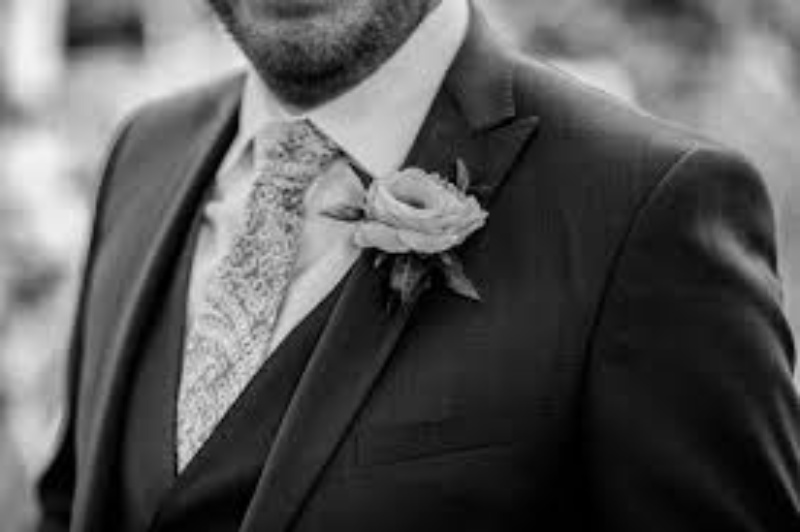
Choose the right fabric
Your choice of fabric is key to help you stay comfortable while still looking sharp. In summer, go for lighter fabrics like linen or cotton, which are breathable and perfect for warmer temperatures.
For winter, wool is your best friend. It’s warm, it’s durable and it can maintains its shape even in colder conditions. Tweed is a great option for cooler months, offering texture and a traditional, elegant feel.

Lounge suit FAQs
1. Can I wear a lounge suit to a black-tie event?
A lounge suit is generally considered too casual for a black-tie event. Black-tie events typically require a tuxedo or a dinner suit, which is a more formal option. However, if the event is labeled as black-tie optional or formal attire, a dark-colored lounge suit can be a suitable choice, especially when paired with a black tie and crisp white shirt.
2. Can I wear a lounge suit without a tie?
While a tie is traditionally worn with a lounge suit, there are occasions when you can skip it. For a more relaxed or semi-formal look, you can wear the suit with an open-collared shirt or even a turtleneck. Just be sure the fit and fabric of the suit still maintain a sharp, polished appearance. When in doubt, a tie adds an extra touch of class, especially for formal occasions.
3. What shoes should I wear with a lounge suit?
Your choice of shoes plays an important role in the overall look of your lounge suit. For more formal occasions, opt for classic black leather oxfords or brogues. If the event is more casual, brown leather shoes or derbies can add a touch of warmth and personality. For summer occasions, you might even consider loafers or monk straps for a laid-back, stylish vibe.
4. What color lounge suit should I choose?
The best color for your lounge suit largely depends on the occasion. Navy blue and charcoal grey are classic, versatile options that can be worn in both formal and semi-formal settings. Black is ideal for formal evening events, while lighter shades like beige or light grey are perfect for spring and summer. You can also experiment with subtle patterns like pinstripes for a modern touch, but always stick to neutral tones for the most timeless look.
5. Can I wear a lounge suit to work?
Absolutely! The lounge suit is an excellent choice for a formal suit, which always be in demanded in professional environment. Depending on your workplace’s dress code, you can wear a lounge suit for daily office wear, business meetings, or client presentations. Pair it with a neat shirt and tie, and you’ll exude confidence and professionalism. If your office is more casual, you can opt for a more relaxed style by removing the tie or wearing a shirt with a more laid-back collar.
In the ever-evolving landscape of menswear, the lounge suit stands as a true classic—refined, versatile, and undeniably stylish. Whether you’re attending a formal daytime event, heading to the office, or simply aiming to elevate your personal style, knowing what a lounge suit is allows you to dress with purpose and poise. It’s more than just a suit; it’s a statement of respect—for the occasion, for the people around you, and for yourself.
Create from my passion about sartorial that I accidently discover when I was searching to upgrade my style, this website is dedicated to providing in-depth knowledge, expert styling tips and the latest trends in men’s tailored fashion. Though sometimes I might sound a little cheesy cuz of all that philosophy book I’ve read 🙂
